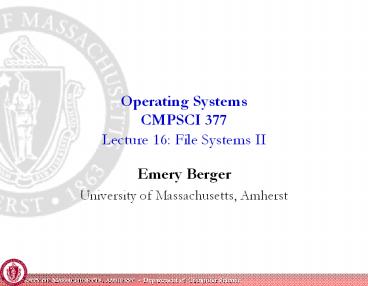Emery Berger PowerPoint PPT Presentation
Title: Emery Berger
1
Operating SystemsCMPSCI 377Lecture 16 File
Systems II
- Emery Berger
- University of Massachusetts, Amherst
2
Outline
- File Systems Implementation
- How disks work
- How to organize data (files) on disks
- Data structures
- Placement of files on disk
3
Disk Surface Layout
- Tracks concentric rings on disk
- bits laid out serially on tracks
- Tracks split into sectors or blocks
- Minimum unit of transfer from disk
4
Disk Pack Multiple Disks
- Disks organized in disk pack stack of platters
- Use both sides of platters
- Two read-write heads at end of each arm
- Cylinders matching sectors on each surface
5
Cost of Disk Operations
- In addition to CPU time to start disk operation
- Latency time to initiate disk transfer
- Seek time time to position head over correct
cylinder - Rotational time time for correct sector to
rotate under disk head - Bandwidth rate of I/O transfer of sectors once
initiated
6
Outline
- File Systems Implementation
- How disks work
- How to organize data (files) on disks
- Data structures
- Placement of files on disk
7
File Organization on Disk
- File system maps file blocks to disk location
- (file 0, block 0) (platter 0, cylinder 0,
sector 0) - Key performance issues
- Support sequential and random access
- What data structure is best for maintaining file
location information? - How do we lay out files on the disk?
8
On-Disk Data Structures
- File descriptor structure used to describe where
file is on disk and attributes - Must be stored on disks just like files
- Most systems fit following profile
- Most files are small
- Most disk space taken up by large files
- I/O operations target both small large
- Per-file cost must be low, but large files must
also have good performance
9
Contiguous Allocation
- Operating system maintains ordered list of free
disk blocks - OS allocates contiguous chunk of free blocks when
it creates a file - Only need to store start location size in file
descriptor
10
Contiguous AllocationPros Cons
- Advantages
- Simple
- Access time? Number of seeks?
- Disadvantages
- Changing file sizes
- Fragmentation? Disk management?
- Examples IBM OS/360, write-only disks, early PCs
11
Linked Files
- Maintain list of all free sectors/blocks
- In file descriptor, keep pointer to first
sector/block - In each sector, keep pointer to next sector
12
Linked Files Pros Cons
- Advantages
- Fragmentation?
- File size changes?
- Efficiently supports which type of access?
- Disadvantages
- Does not support which type of access? Why?
- Number of seeks?
- Examples MS-DOS
13
Indexed Files
- OS keeps array of block pointers for each file
- User or OS declares maximum length of file
created - OS allocates array to hold pointers to all blocks
when it creates file - But allocates blocks only on demand
- OS fills pointers as it allocates blocks
14
Indexed Files Pros Cons
- Advantages
- Wastes very little space
- Sequential random access easy
- Disadvantages
- Sets maximum file size
- Lots of seeks (why?)
15
Multilevel Indexed Files
- Each file descriptor contains 14 block pointers
- First 12 pointers point to data blocks
- 13th pointer one indirection
- Points to block of 1024 pointers to 1024 more
data blocks - 14th pointer two indirections
- Points to block of pointers to indirect blocks
- Used in BSD UNIX 4.3
16
Multilevel Indexed FilesPros Cons
- Advantages
- Simple to implement
- Supports incremental file growth
- Small files?
- Disadvantages
- Indirect access inefficient for random access to
very large files - Lots of seeks (data not contiguous)
- Is file size bounded?
- What could OS do to get more contiguous memory?
17
Free-Space Management Bitmaps
- Need free-space list to keep track of which disk
blocks are free - Akin to free-list for main memory
- One approach bitmap
- One bit per block on disk
- Bit 1 , block is free
- Easy to find any page free in next 32 bits
- Marking block free very simple
18
Free-Space Management
- Problems
- Space Bitmap has big RAM footprint
- 80GB disk, 512 byte sectors 5Mb
- Performance Slow if most of disk is in use
- Alternative link together free blocks
- Head of list cached in kernel memory
- Each block contains next pointer
- Cost of allocation? Freeing? Allocating
consecutive blocks?
19
Summary
- Many of concerns implementations of file
systems similar to virtual memory implementations - Contiguous allocation simple but...
- External fragmentation, compaction, relocation...
- Indexed allocation page tables
- Free space managed with bitmap or linked lists
20
Next Time
- I/O Systems

